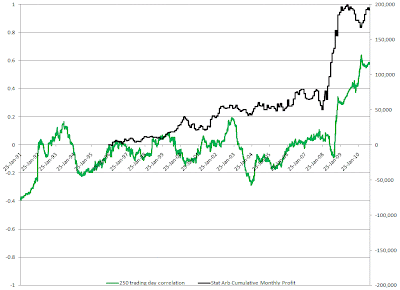Higher correlations between oil and equities has been widely discussed in the financial press. Coinciding with the Global Financial Crisis [GFC], correlations in daily returns have risen from their historical +/-0.2 range to over 0.6.
Hypotheses for this change vary. Some commentators believe this is evidence of ongoing disruption to markets from the GFC, suggesting that this relationship will revert to its historical range once the period of deleveraging has run its course. Others believe it represents a “new normal” driven by the huge increase in commodity investment from index funds and ETFs. Investor sentiment drives funds flow into and out of “risky” assets, both equities and commodities simultaneously, leading to the inevitable increase in correlations.
For most of history, oil prices were considered a countercyclical economic signal. Higher prices for a factor of production led to fears of an inflationary spiral and potentially lower growth and equity valuations. When the rolling correlation is calculated over a 5 year time frame, it has been consistently slightly negative except for a brief period in the run up to the 2003 invasion of Iraq, a period of significant volatility in both markets.
Starting in June-July 2008, the short term correlation turned at first very negative, as oil briefly ran up to its historical peak level of $145.29 even as the stock market was falling rapidly. Then, as reality sank in, the oil market started to trend downwards; the period of high correlation set in.
Stat Arb trading models
Not surprisingly, this transition proved highly profitable for some classes of Stat Arb model. Price movements were large and predictable in the context of equity price movements and the contemporaneous historical relationship. Strategies which had made small gains for several years enjoyed outsized returns during the whole calendar 2008 period.
The chart below shows profitability of a generic directional stat arb model for long/short CL as a function of S&P % gain / loss with a 1-9 business day hold period, overlaid with the rolling 250 day correlation stats.
What is perhaps most striking about this chart is the fact that the stat arb model has not had cumulative profits since May 2009, even as correlation has moved higher. This suggests that the relationship between oil and equities has reached a “new normal”.
While higher correlation appears here to stay, the opportunities to profitably trade one against the other may be gone, at least for the short term.


Well ... how would a period of de-leveraging cause such a strong correlation between commodities and equities? I don't see it.
ReplyDeleteInflation, you've got yourself an explanation. But de-leveraging, I don't get it.